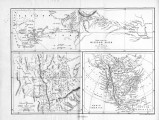| OCR Text |
Show CHAP. VII. THE GREAT SALT LAKE. 325 The lake, which is about the size of the African Chad, occupies the northeastern corner of Utah Territory, and lies to the northwest of the Great Salt Lake Valley, which is forty miles long by about twelve in breadth. The major axis of the irregular parallelogram is sixty to seventy miles in length from north to south, by thirty to thirty-five from east to west. Its altitude has been laid down at 4200 feet above, while the Dead Sea of Palestine is 1300 feet below sea level. The principal influents, beginning from the north, are the Bear Eiver, the Weber Eiver, and the Jordan. They supply the balance of evaporation, which from water is greater, and from high lands is usually less, than the rain. The western side is a perfect desert-a salt and arid waste of clay and sand, with the consistence of mortar when wet, which can not boast of a single stream; even the springs are sometimes separated by " jornadas" of seventy miles. When the rivers are in flood, the lake, it is said, rises to a maximum of four feet, overflowing large tracts of level saline plain, winding between the broken walls of rock which surround it on all sides. Near its shores the atmosphere is reeking, bluish, and hazy, from the effects of active evaporation, and forms a decided change from the purity and transparency of the air elsewhere. Surveyors have observed that it is a labor to use telescopes for geoditic purposes, and that astronomical observations are very imperfect. The quantity of vapor is less, and evaporation has less tension and density from the surface of salt than of fresh water; here, however, the operation is assisted by sunheat sufficient to produce an aeriform state, and by a wind brisk enough to prevent the vapor accumulating over the surface. The water of this remarkable feature, which so curiously reproduces the marvels of Judea, contains nearly one quarter of solid matter, or about six times and a half more than the average solid constituents of sea-water, which may be laid down roughly at three and a half per cent, of its weight, or about half an ounce to the pound.* The Dead Sea is its sole known superior. The specific * "One hundred parts by weight were," says Dr. Gale,''evaporated to dryness in a water-bath below the boilingrpoint, and then heated to about 300° of the thermometer, and retained at that heat till the mass ceased to lose any weight. It gave solid contents 22'422 (?), and consisted of Chloride of sodium (com- \ ln the Abbe mon salt) 20-196 | Domenech's Sulphate of soda 1-834 (work the anal-, Chloride of magnesium. 0-252 fysis is taken' Chloride of calcium a trace I fr0m Col.Fre"- Total 22-282(?)"J mont: thus- The waters of the Dead Sea give solid contents 24-580, and consist of Chloride of sodium 10-360 " "calcium 3-920 " " magnesium 10-246 Sulphate of soda -054 Total 24-580 fChloride of sodium 97-80 " " calcium.... 0-61 " " magnesium 0-24 Sulphate of soda 0-23 " "lime 1-12 Total 100-00 |



















































































































































































































































































































































































































































































































































































































